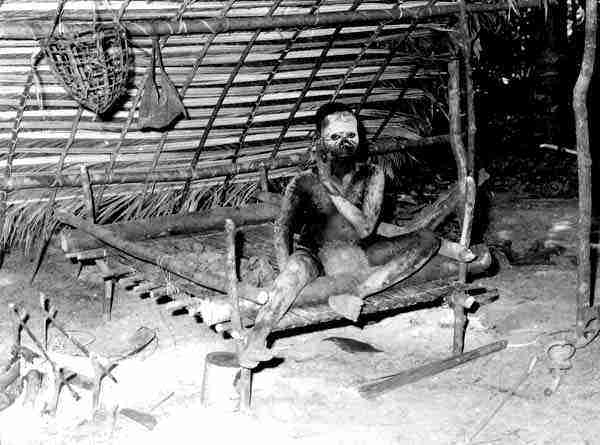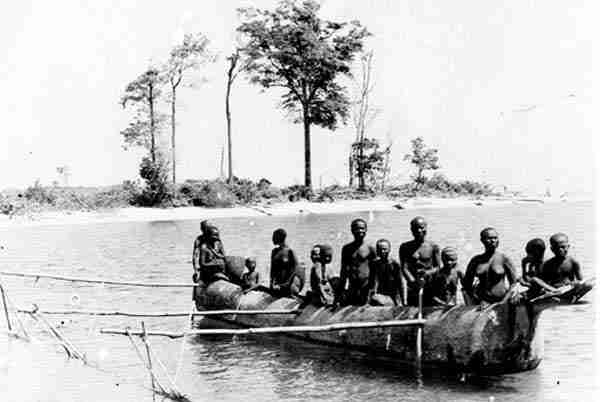Scientific curiosity and the prudery of the time battled mightily within the 19th century authors on matters Andamanese. Prudery usually won, leaving sex and sexual mores as a particularly under-reported field. Moreover, with one major exception, all information we have on Andamanese sexual behavior came from tribes whose culture had been significantly altered and that were on the brink of extinction when first investigated.
The one significant exception refers to the Sentineli. During a visit to North Sentinel island on 29th March 1970, a group of Indian anthropologists including the doyen of Andamanese studies, T.N. Pandit, observed sexual behavior never before (or since) reported from any Andamanese group. An eyewitness observed the following scene from his boat off a Sentineli beach:
... we were about to return when a couple of natives were seen on the land, apparently keeping a vigil. We approached closer, keeping a safe distance from the shore, when more men came out of cover armed with their usual weapons, threatening to shoot at us. We had taken a few large fish caught during the previous night to offer as an appeasement gift to these people. We exhibited these, with gestures of offering. Meanwhile, men were converging on the spot from all direction. Some were waist deep in water and threatening to shoot. However, we approached closer and threw a couple of the fish towards them. They fell short of them and were being carried away by the water. This gesture had a mellowing effect on their belligerent mood. Quite a few discarded their weapons and gestured to us to throw the fish. The women came out of the shade to watch our antics. In their height and stature they were equal to the men except that the lines were softer and they carried no arms... There were 20 children. We approached the coast a little further from them and managed to land a couple of fish on shore. A few men came and picked up the fish. They appeared to be gratified, but there did not seem to be much softening to their hostile attitude. Again we approached the group. They all began shouting some incomprehensible words. We shouted back and gestured to indicate that we wanted to be friends. The tension did not ease. At this moment, a strange thing happened - a woman paired off with a warrior and sat on the sand in a passionate embrace. This act was being repeated by other women, each claiming a warrior for herself, a sort of community mating, as it were. Thus did the militant group diminish. This continued for quite some time and when the tempo of this frenzied dance of desire abated, the couples retired into the shade of the jungle. However, some warriors were still on guard. We got close to the shore and threw some more fish which were immediately retrieved by a few youngsters. It was well past noon and we headed back to the ship...
How is this unique incident to be interpreted? Situations are known from other Andamanese groups when over-excited males were calmed down by the women; none is known to have involved group sex.. In the absence of any hard information about Sentineli behavior, it is pointless to speculate further. What the incident tells is that we don't know the half of it yet.
Radcliffe-Brown researched and published in the early decades of the 20th century, a sexually rather less restrictive time. He also had the added advantage of being an outside visitor, independent of the local establishment. But even he was later upset by the gaps in his own field work:
I am unfortunately obliged to leave a big gap in this chapter and in the book, owing to my inability to discuss the Andamanese notions about sex. The natives of the Great Andaman at the present time show an unusual prudery in their conversation and dealings with white men, but there is good reason to suspect that this is due to the influence of officers who have been in charge of the Andaman Home in former years. At the present time all the men except a few of the oldest in remote parts are very careful never to appear before a white man without some covering although formerly they wore nothing. In their conversations in the presence of a white man they are careful to avoid reference to sexual matters. The men of Little Andaman who have not come under the influence of the Andamanese Homes, still go naked and unashamed, and indulge in obscene gestures and jokes. At the time I was in the Andamans [1906-1908] I failed to realize the very great importance of a thorough knowledge of the notions of a primitive people on matters of sex in any attempt to understand their customs, and therefore failed to make the necessary inquiries.
The difficulty of deciding what was traditional and what was altered post-1858 behavior must be part of any description of Andamanese society. In most cases we simply do not know. The problem is nowhere more acute than on the subject of sex. The sexual freedom said to have been enjoyed by local youths of either sex before marriage among the Greater Andamanese is a case in point. Free love was said to be the rule among the unmarried but that strict fidelity was expected after marriage. The same sources also report that girls were usually married soon after the first menstruation while on the other hand young men who wished to marry before their 18th year were generally held in low public esteem. This leaves the question as to just when precisely the two sexes could make use of their alleged sexual freedom.
We hear of problems that stern guardians of public morals had with their young: they do not sound as if free love was generally accepted. The explanation is likely to be a mixture of traditional and altered sexual behavior, along with the Andamanese propensity to misinform on subjects that were none of the outsiders' business. Andamanese youngsters were not much different from youngsters of any other human group, today or in the past. In spite of all the precautions taken by their seniors, a good deal of flirtatious activity and sometimes more went on in the darkness surrounding the Andamanese village. The young tried not to arouse the suspicions of their elders but did not always succeed. Suspicious guardians would interrogate a suspected party but were lied to as often as any parent of today. Those with a particularly strong moral streak even laid traps for suspected couples. Sometimes the traps worked and the exposed couple had to marry or break up. Much of this hide-and-seek may have been a game between the generations, the rules of which were understood by all participants but not the earnest outside observers. In the claustrophobically close community that was the traditional local group, amazing powers of dissembling would have been required to hide anything from anyone for any length of time. It is more likely that the oldsters knew perfectly well what was going on but owed it to tradition to pretend that they did not. They must have remembered the goings on of their own youth, smiling quietly to themselves.
Perhaps a tad selfishness also helped boost the moral fervor of older people: every marriage removed a pair of valuable helping hands each from two families. Worldly possessions the Andamanese had few but they were not blind to their own material interests and bodily comforts.
While unmarried young people may have had a limited amount of sexual freedom, married couples definitely did not. All we know of traditional Great Andamanese society points in the direction of a strict moral code after marriage. The code was enforced by peer pressure that prevented both partners from straying from the straight and narrow path of virtue. Early British observers hardly ever mention the behavior of the men, choosing instead to go on and on about that of the women who were praised as models of decorum, constancy, delicacy and chastity - after marriage. Whatever the aboriginal women were really like, the Victorian ideals and prejudices of our sources show only too clearly.


